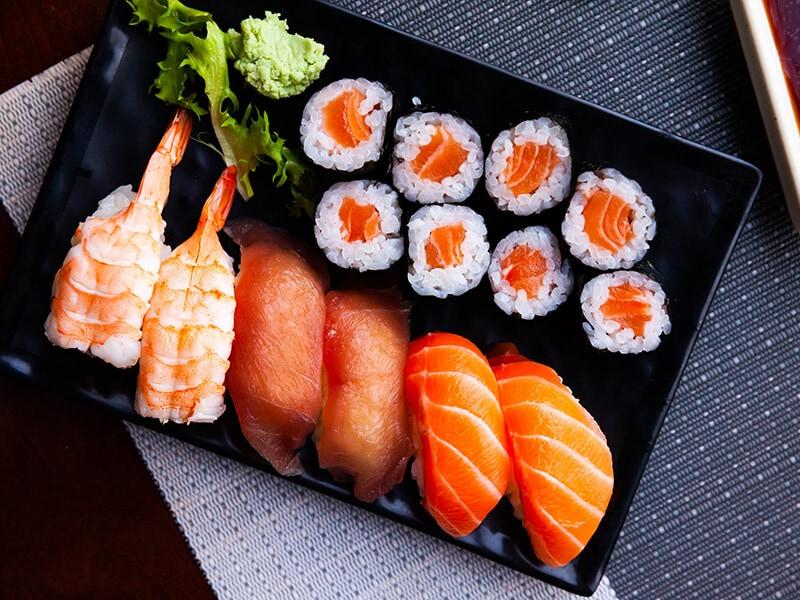The main difference between Sushi vs Maki is that “Sushi” is a Japanese dish of prepared vinegared rice, usually with some sugar and salt. On the other hand, “Maki” is a cylindrical variant of sushi with crispy seaweed wrapped around vinegared rice and some fillings.
Sushi and maki are traditional Japanese dishes that have gained popularity globally. Sushi is a rice dish garnished with fermented fish and other seafood, flavored with vinegar, and often rolled in nori, a dried seaweed sheet. Maki is a variation of sushi, made by wrapping the ingredients in nori or other materials such as omelet, parsley, cucumber, or soy paper. Both dishes can be prepared in various types, with popular options including Futomaki and Hosomaki for maki, and Nigirizushi, Gunkanmaki, Temarizushi, Oshizushi, Inarizushi, Chirashizushi, and Narezushi for sushi. The modern version of sushi was developed in Edo, now known as Tokyo, by Hanaya Yohei and was called Edomae Zushi, as it used to fish from Tokyo Bay. Preparing sushi is relatively easy, with sushi rice as the main ingredient, and various toppings and fillings.

| Parameter of Comparison | Sushi | Maki |
|---|---|---|
| Definition | Sushi is the traditional dish of Japan that comprises of vinegared rice and various other ingredients such as raw fish, seafood, and vegetables. | Maki is a sushi that is cylindrical in shape and includes grilled seaweed nori, that is rolled around vinegared rice and various other fillings. |
| Shape | Sushi can have varying shapes. | Maki is round in shape. |
| Ingredients | Sushi comprises of vinegar flavoured rice and several other ingredients such as raw fish, vegetables and seafood. | Maki comprises of sushi rice, fillings and the seaweed mat (nori). |
| Types | The different types of sushi include: Oshi Zushi (pressed sushi), Nigiri Zushi (hand shaped sushi), Chirashi Zushi (scattered sushi) and Maki Zushi (rolled sushi) | The different types of maki include: hosomaki (thin rolls),uramaki (inside-out roll) futomaki (thick, large or fat rolls) and temaki (hand roll) |
| Presentation | Sushi can be served in a number of ways based on the style of the sushi, but the primary rule of presentation is simplicity. | Maki is served in cylindrical rolls that show layers of fish, vegetables, rice, and seaweed. |
Sushi comes in various types, each with its unique preparation and ingredients. Some popular types include:
- Chirashizushi, which is a bowl of vinegar rice topped with fresh raw meat or fish, sliced into thin pieces and other garnishes.
- Inarizushi, which is filled with vinegar rice in a pouch of tofu, then fried.
- Narezushi, which is a traditional form of fermented sushi, where fish that is skinned, gutted, and fermented for six months with salt is served with rice.
- Nigirizushi, which is an oblong mound of rice topped with wasabi and neta (fish and other ingredients) such as salmon, tuna, and other seafood like octopus, freshwater eel, sea eel, squid, and sweet egg, bound together by a thin strip of nori.
- Oshizushi, which is pressed sushi in the shape of a square, with ingredients topped with rice, pressed together with the help of a wooden mold.
- Makizushi, which is fish and other ingredients rolled in vinegar rice and nori (seaweed) using a bamboo mat, and cut into 6-8 pieces.
Makizushi, also known as rolled sushi, comes in various types, including:
- Futomaki, a large cylindrical piece with a diameter of 2-2.2 inches, filled with two to three ingredients and vinegar rice, rolled in nori. Often vegetarian.
- Hosomaki, a small cylindrical piece with a diameter of 1 inch, filled with one ingredient such as tuna, cucumber, kanpyō, thinly sliced carrots, or avocado, with vinegar rice and rolled in nori.
- Temaki, a large cone-shaped piece of nori filled with various ingredients and meant to be eaten with the hands.
- Uramaki, a medium-sized cylindrical piece filled with two or more ingredients, where the rice is on the outside of the nori.





